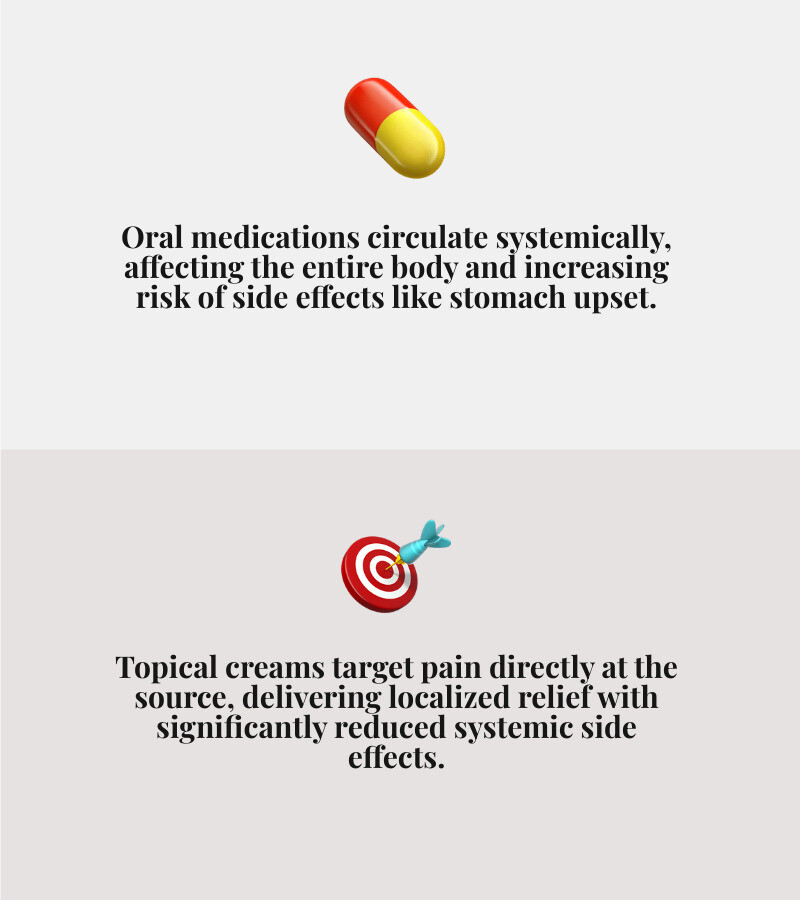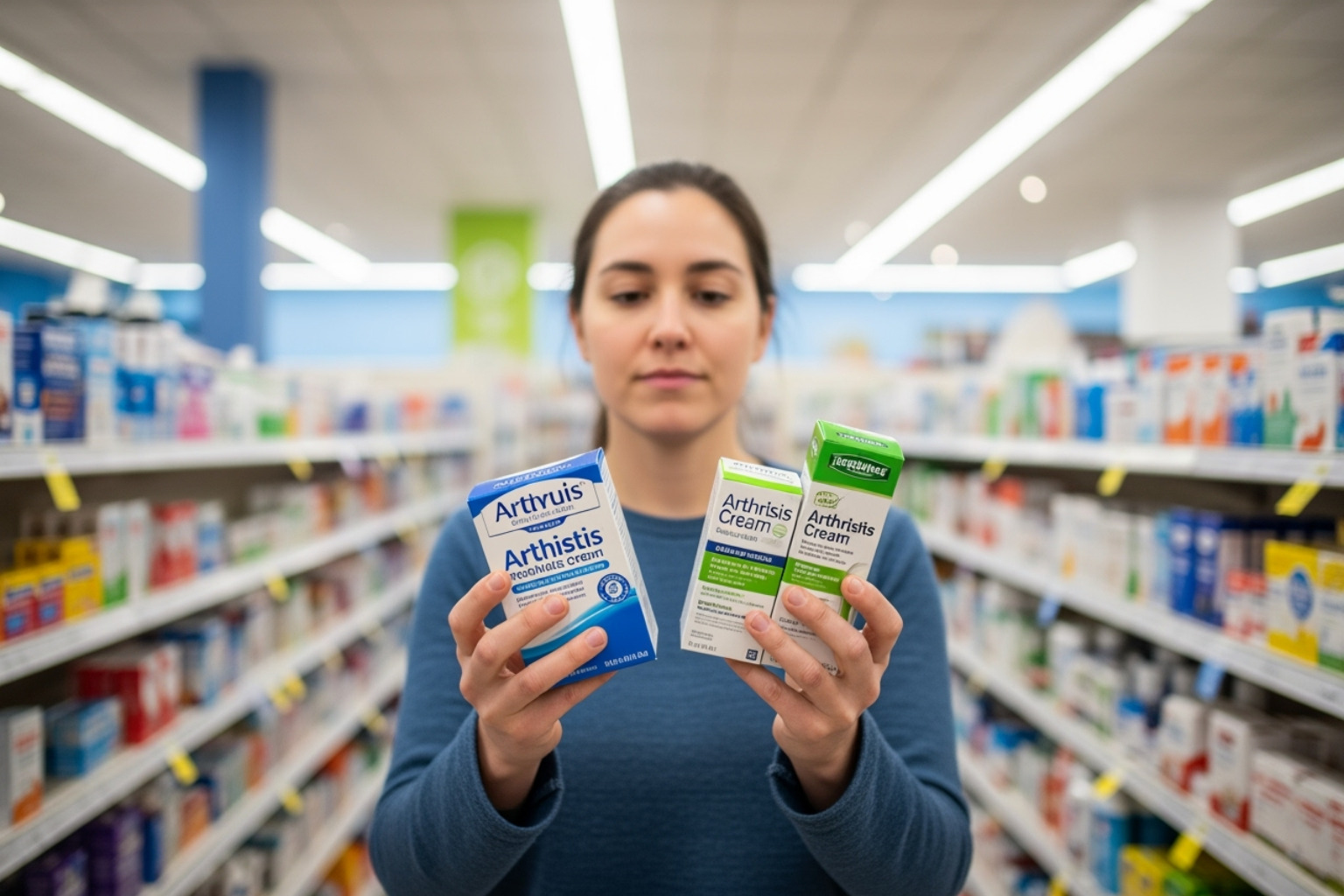A New Approach to Arthritis Pain
Arthritis cream pain relief offers a targeted alternative to oral medications, delivering active ingredients directly to painful joints through the skin. These topical treatments work by reducing inflammation, blocking pain signals, or creating sensations that distract from discomfort.
Quick Guide to Arthritis Cream Pain Relief:
- Topical NSAIDs (like diclofenac) - Reduce inflammation with fewer side effects than pills
- Capsaicin creams - Block pain signals but may take up to 2 weeks for full effect
- Counterirritants (menthol/camphor) - Provide immediate cooling or warming sensations
- Natural ingredients (arnica, turmeric, MSM) - Offer anti-inflammatory benefits with gentle action
- Best for - Joints close to skin surface like hands, knees, and ankles
When joint pain from an active weekend persists despite oral medicine, many people find relief in topical treatments. These creams and gels work without the stomach upset common with pills. Research confirms that topical NSAIDs work as well as oral NSAIDs for many, and capsaicin creams offer significant relief with consistent use. The key advantage is that these treatments target pain at the source, avoiding systemic side effects.
I'm Tony Enrico, and in developing formulations like Neuropasil, I've seen how effective arthritis cream pain relief can be for athletes and individuals managing joint discomfort. My goal is to help people find natural, fast-acting solutions to improve their quality of life.

Understanding How Arthritis Creams Work
When joint pain flares up, topical arthritis cream pain relief offers a direct route to relief. These treatments deliver active ingredients straight through your skin to the source of your discomfort.
Unlike oral medications that travel through your entire bloodstream, topical analgesics work locally. This targeted approach concentrates the treatment exactly where you need it, minimizing exposure to the rest of your body. This often means fewer side effects and faster action.
Arthritis cream pain relief works through several mechanisms. Some formulations reduce inflammation, the root cause of aching. Others interrupt pain signals before they reach your brain. Many create cooling or warming sensations that distract your brain from the underlying discomfort.
This approach works best for joints close to your skin's surface, like hands, wrists, knees, and ankles, where active ingredients can easily reach the problem area. Deeper joints like hips or shoulders can still benefit, though relief might be more modest. Topical treatments come in creams, gels, or patches, offering a practical alternative to pills for everything from morning stiffness to post-activity soreness.
For a deeper understanding of how osteoarthritis affects your joints, check out our comprehensive guide: More info about Osteoarthritis.
The Science Behind Key Active Ingredients

Understanding how different ingredients work helps you choose the best arthritis cream pain relief for your needs.
Topical NSAIDs like diclofenac block the production of prostaglandins, which are chemicals that create inflammation and pain. They can be as effective as oral versions but with a much lower risk of stomach or cardiovascular issues.
Salicylates, found in products like Aspercreme, provide anti-inflammatory action similar to aspirin. They are effective for mild to moderate pain, but those with aspirin allergies or on blood thinners should consult a doctor.
Capsaicin, derived from chili peppers, depletes a chemical called Substance P that transmits pain messages to the brain. Over time, this turns down the volume on your pain signals.
Counterirritants like menthol and camphor create strong cooling or warming sensations that distract your brain from the deeper ache in your joints.
Topical anesthetics such as lidocaine numb the area by blocking pain signals at the nerve endings, providing localized relief.
Natural and Alternative Ingredients
Many arthritis cream pain relief products use powerful botanical ingredients.
Arnica is a traditional anti-inflammatory that reduces swelling and pain in joints and muscles.
Turmeric contains potent anti-inflammatory compounds that can calm arthritis pain when applied topically.
Aloe vera offers anti-inflammatory compounds that reduce swelling while hydrating the skin.
MSM (Methylsulfonylmethane) is an organic sulfur compound that penetrates the skin to decrease inflammation, reduce pain, and improve joint mobility.
Tea tree oil provides both antibacterial and anti-inflammatory benefits, helping to reduce redness and swelling.
At Neuropasil, our formulations combine the cooling relief of menthol with the soothing properties of aloe for fast-acting, targeted relief. These natural solutions offer effective alternatives for managing chronic conditions. Learn more in our guide on Nerve Pain Relief with Natural Solutions.
Capsaicin-Based Creams
Capsaicin works by targeting Substance P, a chemical messenger that carries pain signals to your brain. When first applied, capsaicin cream causes a temporary burning sensation. With consistent use, it depletes your nerve cells of Substance P, preventing pain signals from reaching your brain.
This process takes time, often up to two weeks for noticeable relief and four weeks for maximum benefit. Patience and consistency are crucial. Apply the cream three to four times daily as directed. Sporadic use will only cause the initial burning without the long-term benefits.
Always wash your hands thoroughly with soap and water after application to avoid transferring it to your eyes or other sensitive areas. If treating your hands, wait 30 minutes before washing. Never combine capsaicin with heat sources like heating pads, and do not apply it to broken or irritated skin. While the initial discomfort can be a challenge, many find the sustained relief is worth it. Capsaicin creams are widely available at most pharmacies.
Counterirritants (Menthol & Camphor)
Menthol and camphor work through strategic distraction. They don't heal tissue but create strong sensory input that overrides the arthritis pain signals traveling to your brain.
When you apply a menthol-based cream, it stimulates cold receptors, creating a cooling sensation. Camphor typically creates a warming sensation. Both flood your sensory nerves with signals that crowd out pain messages.
This makes counterirritants excellent for immediate, temporary relief when you need to get moving despite stiff joints. The effect provides a crucial window of comfort to start your day or get through an activity. Popular products like Bengay and Icy Hot are built on this principle.
At Neuropasil, we harness menthol's power as both a counterirritant and a local anesthetic. Our customers appreciate the rapid cooling sensation followed by targeted relief, which is particularly effective for nerve pain and muscle soreness.
Choosing the Right Arthritis Cream Pain Relief For You
With so many options, finding the perfect arthritis cream pain relief is about understanding your specific needs. What works for one person's knee might not be ideal for another's hand.

The key questions are straightforward: Which joint hurts? and How intense is the pain? Your skin also plays a role. Consider your skin sensitivity and scent preferences, as some people love the smell of menthol while others prefer odor-free options.
Comparing Popular Natural Ingredients
This chart breaks down the most effective natural options you'll find:
| Ingredient | Source | Mechanism | Sensation (Hot/Cold) | Best For |
|---|---|---|---|---|
| Arnica | Plant extract | Anti-inflammatory, reduces swelling and pain by stimulating white blood cells | Neutral | Reducing swelling, bruising, muscle aches, joint pain |
| Capsaicin | Chili peppers | Depletes Substance P (pain neurotransmitter) from nerve endings | Warming/Burning | Chronic osteoarthritis pain, nerve pain (with consistent use) |
| Menthol | Peppermint plant | Counterirritant, stimulates cold receptors, then provides mild warmth | Cooling, then warming | Immediate distraction from pain, muscle soreness, nerve pain, temporary relief |
| MSM | Organic sulfur compound | Anti-inflammatory, reduces pain, improves joint mobility and tissue repair | Neutral | Decreasing inflammation, improving joint function, muscle recovery |
Think of this as your ingredient cheat sheet. Arnica is a gentle, all-around helper. Capsaicin requires patience but offers impressive long-term results. Menthol is a sprinter, offering immediate relief. MSM works quietly to support joint health.
Factors to Consider for Your Specific Needs
Your body's unique situation should guide your choice. Location matters; creams work best on joints close to the skin like hands and knees. Deeper joints like hips or shoulders are more challenging, but many people still find relief.
Pain severity is another factor. For mild discomfort, a gentle natural option may suffice. For moderate, daily pain, a topical NSAID might be more effective.
Your health history is critical. If you have allergies to aspirin, avoid salicylate creams. People with chronic conditions like heart or kidney disease often find topicals safer than oral medications, but this is a conversation to have with your doctor.
The beauty of arthritis cream pain relief is the variety of options available. Whether you're managing osteoarthritis, a sports injury, or age-related joint pain, there's likely a topical solution for your comfort toolkit. The key is matching the right ingredient to your situation and consulting your doctor when unsure.
Best Practices for Application and Safety
Getting the most from your arthritis cream pain relief isn't just about choosing the right product—it's about using it correctly. Proper application maximizes effectiveness and ensures safety.

With a few simple techniques, you can ensure you're getting every bit of relief your cream can offer.
How to Apply Creams for Maximum Arthritis Cream Pain Relief
Follow these steps to ensure you get the best results from your topical treatment:
- Start with clean, dry skin. Wash the area with soap and water to remove oils and dirt that could block absorption.
- Read the package directions. Every product is different. Some, like Voltaren Gel, include dosing cards to help you measure the correct amount for different body parts. Precision ensures optimal results without waste or overuse.
- Massage gently but thoroughly. Work the cream into your skin with circular motions until it's fully absorbed. This also helps increase blood flow to the area.
- Be consistent. Most arthritis cream pain relief products recommend application up to four times daily. Sticking to a schedule is especially crucial for capsaicin creams to achieve long-term relief.
- Wash your hands. After applying, wash your hands thoroughly with soap and water, unless you are treating your hands. If so, wait at least 30 minutes before washing. This prevents accidentally spreading the cream to your eyes or other sensitive areas.
Potential Side Effects and When to Consult a Doctor
While generally gentler than oral medications, topical treatments can cause side effects. Knowing what to watch for is key.
Skin reactions are the most common issue. You might experience mild redness or burning, especially when starting a new product. With capsaicin, an initial burning sensation is normal and usually subsides within a week of consistent use.
Stop use if you have an adverse reaction. If you develop a rash, severe itching, or hives, you may be having an allergic reaction. Also, stop using the product if your pain worsens.
Avoid broken or irritated skin. Never apply arthritis cream pain relief to cuts, scrapes, or rashes. A compromised skin barrier increases absorption and the risk of irritation.
Do not combine with heat. Avoid using heating pads or tight bandages over areas where you've applied counterirritant or capsaicin creams, as this can cause skin irritation or burns.
Consult a doctor if symptoms persist. If skin irritation or pain continues or worsens after a week, it's time to call your doctor. Also, if you have an aspirin allergy, take blood thinners, or have heart or kidney disease, check with your healthcare provider before starting any new topical treatment.
For more strategies, explore our guide on Managing Arthritis Pain Long-Term. Your healthcare team can help you steer these choices safely.
Frequently Asked Questions about Arthritis Cream Pain Relief
It's natural to have questions when exploring arthritis cream pain relief options. Here are answers to the most common concerns.
How long does it take for arthritis creams to work?
The time to feel relief depends on the active ingredients.
- Counterirritants (menthol, camphor): These work within minutes, providing a cooling or warming sensation that distracts from pain. The relief is immediate but temporary.
- Topical NSAIDs (diclofenac): You may notice relief within a few hours, with anti-inflammatory effects building over several days of consistent use.
- Capsaicin creams: These require patience. While you'll feel the initial warming sensation right away, true pain relief can take up to two weeks of daily application, with maximum benefit appearing after a month.
- Natural ingredients: The timeline varies. Ingredients like menthol, which we use in Neuropasil, offer immediate cooling, while others provide more gradual anti-inflammatory benefits over days or weeks.
Can I use arthritis creams with other pain medications?
This is a critical question. In many cases, arthritis cream pain relief products can be used alongside oral medications, as they work locally with minimal systemic absorption. Many doctors recommend this combination approach.
However, you must talk to your doctor or pharmacist first. This is especially important if you take blood thinners or have an aspirin allergy, as creams containing salicylates could cause interactions. Even with topical NSAIDs, some medication is absorbed into the bloodstream, so your healthcare provider needs to know everything you're using to create a safe and effective pain management plan.
Are topical treatments as effective as pills for arthritis?
The answer depends on the situation, but the results are often impressive.
For joints close to the skin's surface—like hands, knees, and ankles—topical treatments can be just as effective as oral medications. Research shows that topical NSAID creams like diclofenac provide comparable relief to oral NSAIDs for these areas, but with significantly fewer systemic side effects.
Capsaicin creams also have solid evidence supporting their use for chronic osteoarthritis, provided they are used consistently. While natural ingredients may have less extensive clinical research, their real-world effectiveness is clear. Our Neuropasil customers frequently report significant relief from joint discomfort using our natural formulations.
Topical treatments are powerful tools in a comprehensive pain management strategy. They can help reduce reliance on pills, provide targeted relief between doses, or serve as a gentler alternative for those who experience side effects from oral medications. For people with certain health conditions, topicals may even be the preferred option.
Conclusion: Take Control of Your Joint Pain
Finding the right arthritis cream pain relief is about reclaiming your life from joint pain. Topical treatments offer a unique advantage: the ability to target pain directly at the source, without the systemic side effects of oral medications.
The science is clear: these treatments work. Whether you choose the proven power of a topical NSAID, the unique nerve-targeting action of capsaicin, or the immediate cooling of a menthol-based cream, you have the knowledge to make an informed choice. At Neuropasil, we've seen how combining the fast-acting relief of menthol with the soothing properties of aloe can transform a person's daily experience with pain.
Your journey is unique. You deserve options that fit your lifestyle, skin sensitivity, and pain patterns. Remember the golden rules: apply to clean skin, follow directions, wash your hands, and always consult your healthcare provider with questions.
Topical treatments shine brightest as part of a bigger picture. Combining your chosen cream with gentle exercise, stress management, and open communication with your doctor creates a comprehensive approach to pain management.
You now understand how different ingredients work and how to use them safely. Don't let joint pain write the story of your days. Explore your options, be patient with the process, and remember that finding the right arthritis cream pain relief is a powerful step toward moving more freely and living more comfortably.
For a comprehensive guide to managing your arthritis pain with lifestyle strategies, exercise tips, and long-term approaches that complement your topical treatments, visit: Find a comprehensive guide to managing your arthritis pain.














